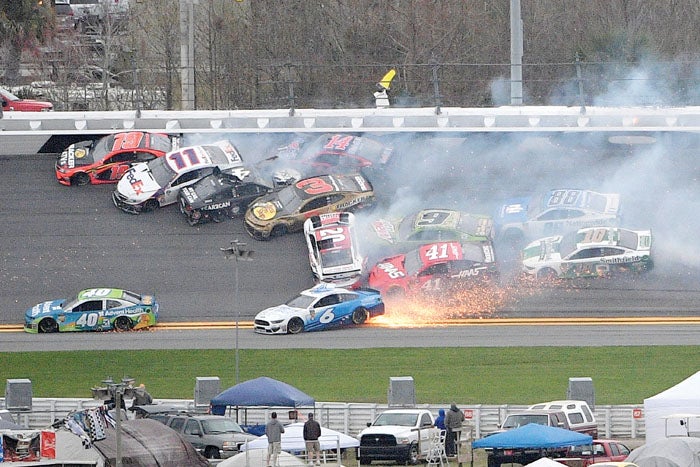NASCAR moving away from restrictor plates, not pack racing
Published 11:14 pm Friday, February 15, 2019

- Martin Truex Jr. (19), Denny Hamlin (11), Kevin Harvick (4), Austin Dillon (3), Clint Bowyer (14), Erik Jones (20), Chase Elliott (9), Daniel Suarez (41), Ryan Newman (6), Alex Bowman (88) and Aric Almirola (10) are involved in a multi-car pileup during the NASCAR Clash auto race at Daytona International Speedway Sunday, Feb. 10, 2019, in Daytona Beach, Fla. (AP Photo/Phelan M. Ebenhack)
By MARK LONG, AP Sports Writer
DAYTONA BEACH, Fla. (AP) — There has been a string of goodbyes at Daytona International Speedway in recent years, from Jeff Gordon and Tony Stewart to Dale Earnhardt Jr. and Danica Patrick.
There is another one on tap Sunday: The Daytona 500 will be the final NASCAR race for restrictor plates, the horsepower-sapping devices reduce speed and were intended to improve safety at the nation’s fastest tracks.
Don’t expect a big send-off for the oft-maligned part, which has been in use since 1988. NASCAR is merely switching to tapered spacers at every track to keep speeds in check.
“No matter what you call it, you’re still restricting the air flow to the engine,” two-time Daytona 500 winner and 1988 NASCAR champion Bill Elliott said. “It’s just a different flavor, a different way of putting it. I guess it’s all about how you word things these days.”
Plate racing has drawn plenty of criticism over the years, mostly from drivers and team owners who prefer cars not be bunched together in two- and three-wide packs at nearly 200 mph and where the slightest contact creates a chain reaction and often mangles a bunch of $300,000 cars. During this month’s Speedweeks, though, the package has created less-than-ideal, single-file racing that has some wondering what the 61st running of “The Great American Race” will look like.
NASCAR implemented the use of restrictor plates at Daytona International Speedway and Talladega Superspeedway as a safety measure more than three decades ago. The hope was that slower cars would be less likely to go airborne following Bobby Allison’s crash at Talladega in May 1987. His car sailed into the catch-fence, spewing debris into the stands.
That same year, Elliott set qualifying records at both tracks, reaching 210.364 mph at Daytona and 212.809 at Talladega. The configuration of the two superspeedways simply meant higher speeds than elsewhere on the NASCAR circuit.
Slowing down the cars was the quick and easy fix.
“I probably contributed to restrictor plates quite a bit,” Elliott said. “If I hadn’t done it, somebody else would have come along and done it. We can always look back and say, ‘Well, we should have done this or should have done that.’ Here we are 32 years later, and if they would have left the engines unrestricted, guys would be doing 230-plus now.”
Drivers expect little effect from the switch, even though the parts are distinctly different.
Restrictor plates are an eighth of an inch, so thin that any imperfection — even a scratch — can create a disparity.
Tapered spacers are precisely machined and provide much more even air distribution, essentially making them more efficient.
“I don’t think there will be a lot of change,” said 2012 NASCAR champion Brad Keselowski, who has won four of the last 20 races at Daytona and Talladega. “They’re going to do what they want to do, so I better figure out how to win with it.”
Tapered spacers have been used in NASCAR’s Cup Series since 2015, when a 1.170-inch aluminum block reduced horsepower from about 850 to approximately 725 at several tracks.
The 2019 rules package mandates those same-sized spacers at all tracks less than 1.33 miles. A 0.922-inch spacer will be used at all oval tracks 1.33 miles and above, which will decrease engine horsepower to about 550. That includes Daytona and Talladega, but won’t take effect until after Sunday’s season opener.
NASCAR’s expectation is that reducing horsepower — in connection with a larger spoiler that creates more downforce — will slow the cars down, lead to more stability for drivers and produce tighter racing.
“I totally expect to crash more cars,” defending series champion Joey Logano said. “As cars are closer and drivers are more aggressive, a mistake will create a bigger crash. We can’t get away from it. … You know how it is when you’re on the highway and they check up right in front of you. You can’t stop quick enough and you’re only going 70, you know? Try going 180. Game changes a little bit.
“So I assume there will be more crashes. I assume we’re all going to tear more stuff up this year. And usually when there’s more crashes, there’s more conflict. So it will be interesting. Hang on.”
All of it is designed to give fans what they want: better, more dramatic races — much like they’ve had at Daytona and Talladega for 30-plus years.
“Nobody knows exactly what to expect,” Stewart-Haas Racing team co-owner Tony Stewart said. “Having a restrictor-plate package, open package, this new package, we’re all excited to see what it produces. At the end of the day, it’s all about making the racing more exciting for the fans, re-engaging the fans in the sport.
“I think restrictor-plate racing at Daytona and Talladega is always going to be an element of its own that really is separate from what you see the rest of the season.”
___
More AP auto racing: https://apnews.com/apf-AutoRacing and https://twitter.com/AP_Sports





